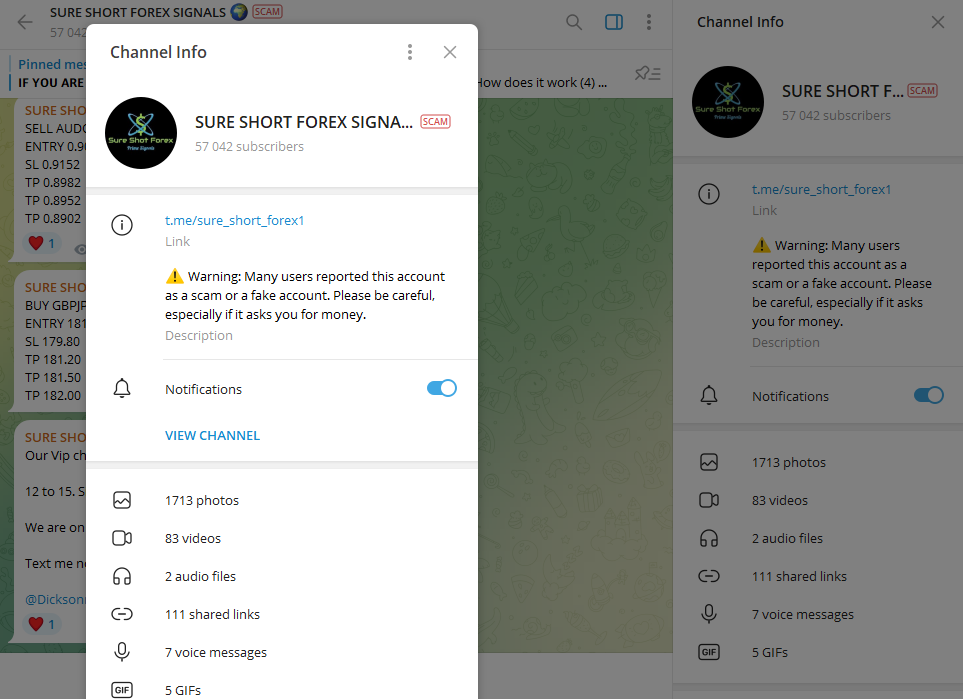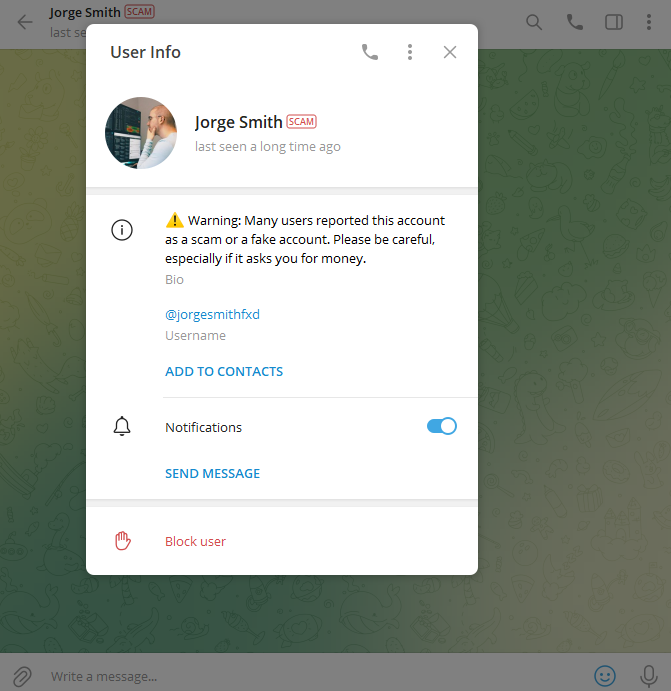This article provides an in-depth look at Telegram scams, covering various aspects and specific types of scams encountered in 2022-2023. Here's what you'll find in the article:
Scamming Techniques on Telegram: From Classiscam to Advanced Frauds
How to Identify a Scammer
2024 Scamming Methods on Telegram
Detailed Investigation Of Telegram Scam Groups and Channels
Real Case Scams Examples
Reporting Scams on Telegram
Legit Telegram Groups and Channels
How Much Victims Lost in 2022-2023 on Telegram Scams?

This is detaied report on the financial losses incurred by victims in various types of scams on Telegram:
Impersonation Scams: In Singapore, about 50 people lost a total of at least $18,000 in 2023 due to impersonation scams on Telegram. The scammers hijacked victims' accounts by tricking them into providing mobile phone numbers and Telegram-generated login codes.
Fraudulent Check Scheme: Between October 2022 and August 2023, a scheme involved selling stolen or fraudulent checks on a Telegram channel called “Work Related Slips.” Thousands of these checks were posted, affecting individuals, municipalities, utilities, churches, nursing homes, schools, non-profit groups, and businesses, especially in the Northern District of Alabama. The total value of the fraudulent checks exceeded $15 million.
Cross-Platform Impersonation Scams: More than 120 people lost at least $330,000 to impersonation scams that spanned various platforms, including Telegram. These scams often involved asking victims to help verify or unblock a restricted Telegram account of a known contact.
Shopee Impersonation Scam: In a specific case involving Shopee, at least 46 individuals were duped by scammers posing as Shopee employees on WhatsApp and Telegram, leading to a total loss of over $750,000. The scammers recruited victims by impersonating Shopee employees, sometimes providing fake identification.
These examples highlight the significant financial impact of Telegram scams on individuals and organizations, underscoring the importance of vigilance and awareness in digital communications to avoid falling victim to such fraudulent activities.
Scamming Techniques on Telegram: From Classiscam to Advanced Frauds

Fake Telegram Groups and Channels
These are a sophisticated form of deception on the Telegram platform, where scammers create counterfeit versions of legitimate groups and channels. These are designed to mimic the appearance and behavior of authentic entities to dupe users.
How They Operate:
1. Replication of Legitimate Channels: Scammers replicate popular Telegram channels or groups in great detail. This includes copying the names of administrators, the style of pinned messages, and even the type of media posted. The objective is to make these fake entities look as close to the original as possible to gain trust.
2. Attracting Users: The fake channels and groups present themselves as genuine, capitalizing on the credibility of the original channels. They often target large and popular communities to have a broader pool of potential victims.
3. Simulated Activity: To give an impression of legitimacy, these channels often showcase a high level of activity. This may involve automated messages or bots that simulate real user interactions.
Goals of Scammers:
• Personal Information Theft: The primary goal is often to trick users into giving away personal information, which can be used for identity theft or other fraudulent activities.
• Financial Fraud: Users may be lured into participating in scams, such as fake giveaways, investment opportunities, or buying non-existent products, leading to financial losses.
Preventative Measures:
1. Critical Evaluation: Before joining a group or channel, carefully evaluate its authenticity. Check for discrepancies in usernames, the quality and relevance of content, and compare with verified channels.
2. Caution with Links: Be wary of clicking on links shared within these groups, especially if they promise high returns or exclusive access to products or services.
3. Adjusting Privacy Settings: Modify your Telegram settings to restrict who can add you to groups and channels, reducing the risk of being added to fraudulent ones.
4. Reporting Suspicious Channels: If you encounter a fake group or channel, report it immediately to Telegram. This helps in taking down fraudulent entities and protecting other users.
Impersonation Scams on Telegram

Overview: Impersonation scams on Telegram involve fraudsters creating false identities or accounts that mimic trusted entities, such as well-known companies, customer service representatives, or even acquaintances. These scams exploit the trust and recognition associated with the impersonated entity to deceive victims.
Mechanics of the Scam:
1. Creating False Identities: Scammers craft profiles that closely resemble those of legitimate individuals or organizations. This can include using similar usernames, profile pictures, and other identifiable details.
2. Establishing Trust: By impersonating a known entity, scammers aim to gain the victim’s trust quickly. For example, posing as customer support for a well-known service can create a false sense of security in the victim.
3. Engaging with Victims: The scammer, under their false identity, initiates contact with potential victims, often using convincing narratives that require urgent action or response.
Goals of Impersonation Scams:
• Financial Fraud: Convincing victims to transfer money, share credit card details, or engage in transactions under false pretenses.
• Information Theft: Collecting sensitive personal information, which can be used for identity theft, account takeovers, or further scams.
Prevention and Safety Tips:
1. Verify Identities: Always cross-check and verify the identities of individuals or entities that contact you, especially if they ask for personal or financial information.
2. Be Skeptical of Unsolicited Messages: Exercise caution if you receive unexpected requests or instructions, even if they seem to come from a known contact or organization.
3. Use Official Channels for Communication: If in doubt, contact the company or individual through official and verified means, such as through their official website or known contact numbers.
4. Awareness of Tactics: Recognize that urgency and high-pressure tactics are common in these scams, aiming to rush victims into making decisions without proper verification.
Key Takeaways:
• Impersonation scams on Telegram are a significant threat, using the guise of trusted individuals or entities to exploit users.
• They involve carefully crafted false identities to deceive victims into sharing personal or financial information.
• Vigilance, skepticism, and proactive verification are crucial in identifying and avoiding these scams.
Classiscam on Telegram

This a specific type of scam on Telegram that involves the creation of fake listings on classified sites and leveraging bot accounts to conduct fraudulent activities. This scam has swindled significant amounts of money from victims by exploiting the trust people place in online marketplaces and classified ad platforms.
How It Operates:
1. Fake Listings: Scammers create bogus listings on classified sites for items like cameras, laptops, and smartphones. These listings often feature attractive prices to lure potential victims.
2. Redirecting to Telegram: The fraudulent ads encourage interested buyers to contact the seller on Telegram for further discussion. This step moves the conversation to a platform where scammers have more control and can evade the security measures of legitimate sites.
3. Bot Interaction: Once on Telegram, victims are often put in touch with bots disguised as genuine sellers. These bots are programmed to extract personal and financial information from the victims under the pretext of completing the sale.
4. Lookalike Webpages: In some cases, victims are sent links to web pages that closely resemble legitimate marketplace sites (like Craigslist or Facebook Marketplace). These sites then ask for personal details, including credit card information, under the guise of completing the transaction.
Prevention and Safety Tips:
1. Verify Listings: Always cross-check the legitimacy of online listings and be cautious of deals that seem too good to be true.
2. Avoid Shifting Platforms: Be wary of sellers who insist on moving conversations to third-party platforms like Telegram.
3. Look for Red Flags: Be alert to signs of a scam, such as inconsistencies in communication, urgency to complete the transaction, or requests for personal financial information.
4. Use Secure Payment Methods: Always use secure and traceable payment methods and avoid direct transfers to individuals for online purchases.
Key Takeaways:
• Classiscam exploits the popularity of online marketplaces and classified ads, using Telegram as a medium to conduct fraudulent activities.
• It involves sophisticated tactics like using bots and creating lookalike websites to deceive victims.
• Awareness and caution are vital in identifying and avoiding falling victim to such scams on Telegram.
Phishing Attacks on Telegram

When scammers tricking users into revealing sensitive personal information, such as login credentials, financial details, or other confidential data. These scams often take place under the guise of legitimate requests or notifications.
How Phishing Works on Telegram:
1. Deceptive Messages: Scammers send messages that appear to be from trusted sources, like financial institutions, well-known companies, or even contacts within the user's network. These messages often contain urgent or alarming content to prompt immediate action.
2. Malicious Links: The messages typically include links that lead to fake websites designed to look like legitimate portals. Users are misled into entering sensitive information on these sites, thinking they are authentic.
3. Information Harvesting: Once the user inputs their information on these fraudulent sites, the scammers collect the data for malicious purposes, such as identity theft, financial fraud, or unauthorized access to accounts.
Goals of Phishing Attacks:
• Stealing Personal Data: Acquiring sensitive personal information that can be used for various illegal activities.
• Financial Theft: Gaining access to victims' financial accounts or credit card details for monetary gain.
• Account Takeover: Using stolen login credentials to gain unauthorized access to victims’ accounts for further malicious activities.
Prevention and Safety Tips:
1. Verify Source Authenticity: Always confirm the authenticity of any message that requests personal information. This can be done by directly contacting the supposed source through official channels.
2. Avoid Clicking Suspicious Links: Be cautious about clicking on links in messages, especially if they prompt for personal or financial information.
3. Enhanced Vigilance: Be particularly wary of messages that create a sense of urgency or pressure to act quickly, as this is a common tactic in phishing scams.
4. Use Secure Connections: Ensure that any website you input sensitive information into is secure (look for 'https://' in the URL and a lock symbol).
Key Takeaways:
• Phishing on Telegram is a significant threat, with scammers using the platform to send deceptive messages containing malicious links.
• The objective is often to extract sensitive information for financial theft, identity theft, or unauthorized account access.
• Vigilance, skepticism, and verification are essential in identifying and avoiding phishing attacks on Telegram.
Social Engineering on Telegram

Overview: Social engineering on Telegram refers to the manipulative techniques scammers use to trick users into divulging confidential information, financial details, or performing actions that compromise their security. Unlike direct hacking, social engineering exploits human psychology and trust.
How Social Engineering Works on Telegram:
1. Building Trust: Scammers often create a façade of legitimacy or authority to gain the victim's trust. This can be achieved by impersonating a known contact, company, or authority figure.
2. Urgency and Fear Tactics: These scams typically involve creating a sense of urgency or fear. For example, scammers might claim that there's an issue with a victim’s bank account or a security breach that requires immediate action.
3. Phishing Attempts: A common tactic is to send messages with links to fake websites where victims are tricked into entering sensitive information, believing they are taking necessary security measures.
4. Exploiting Emotional Responses: Scammers may also exploit emotional triggers, such as a plea for help (e.g., from a 'friend in need') or the promise of a romantic relationship in romance scams.
Goals of Social Engineering:
• Information Theft: Acquiring personal or financial information for malicious activities like identity theft or financial fraud.
• Access to Accounts: Gaining unauthorized access to victims' accounts, including social media, banking, or other personal accounts.
• Monetary Gain: Direct financial exploitation, such as convincing victims to transfer money under false pretenses.
Prevention and Safety Tips:
1. Verify Sources: Always verify the identity of the person or entity contacting you, especially if they request sensitive information or actions.
2. Be Skeptical of Urgent Requests: Treat unexpected messages with urgency or fear-inducing content with skepticism. Legitimate organizations typically do not ask for sensitive information via messaging apps.
3. Protect Personal Information: Be cautious about sharing personal information, especially in response to unsolicited communications.
4. Educate Yourself: Familiarize yourself with common social engineering tactics to better recognize and avoid them.
Key Takeaways:
• Social engineering on Telegram leverages psychological manipulation rather than technical hacking methods.
• Scammers use various tactics, including impersonation, urgency, and emotional manipulation, to deceive their victims.
• Being vigilant, verifying sources, and safeguarding personal information are key strategies in preventing social engineering scams on Telegram.
Sophisticated Telegram Frauds

Overview: Sophisticated frauds on Telegram are complex scams involving advanced tactics and deceptive strategies that go beyond simple phishing or impersonation. These scams often utilize a combination of technological tools and psychological manipulation to exploit victims.
Characteristics of Sophisticated Frauds:
1. Advanced Technical Methods: These scams may involve the use of bots, malware, or complex phishing techniques designed to seem highly authentic and bypass standard security measures.
2. Multi-Stage Scams: Sophisticated frauds often occur in multiple stages, starting with gaining trust or gathering initial information, and progressively leading to more significant deception or theft.
3. Highly Convincing Scenarios: Scammers create plausible scenarios, often mimicking real-life situations or legitimate business processes, to lull victims into a false sense of security.
Common Types of Sophisticated Frauds on Telegram:
• Investment Scams: Using detailed and convincing narratives about lucrative investment opportunities, often backed by fake testimonials or documentation.
• Crypto-Related Frauds: Involving detailed schemes related to cryptocurrency trading or investments, often leveraging the complexity and novelty of crypto markets to confuse victims.
• Elaborate Phishing Operations: Using advanced phishing methods, including creating entire websites that mimic legitimate services or businesses.
Goals of These Scams:
• Financial Exploitation: The primary goal is usually to defraud victims of significant amounts of money.
• Long-Term Deception: In some cases, the objective may be to establish a long-term deceptive relationship with the victim for ongoing exploitation or theft.
Prevention and Safety Tips:
1. Due Diligence: Conduct thorough research and verification before engaging in any transaction or interaction that involves personal or financial information.
2. Seek Expert Advice: For complex matters, especially involving investments or cryptocurrencies, consult with legitimate and recognized experts.
3. Be Wary of Unsolicited Offers: Approach unsolicited offers or opportunities, especially those received via Telegram, with a high degree of skepticism.
4. Use Trusted Platforms: For financial transactions or investments, use only trusted and verified platforms or services.
Key Takeaways:
• Sophisticated frauds on Telegram utilize advanced techniques and create highly convincing scenarios to deceive victims.
• These scams can be multi-faceted and often target financial assets or sensitive personal information.
• Vigilance, thorough verification, and a cautious approach to unsolicited offers are crucial in protecting oneself from these sophisticated scams on Telegram.
How to Identify a Scammer?

Identifying scammers on Telegram involves being vigilant and aware of common scam indicators. Here's a guide to help you spot potential scams:
1. Unsolicited Contact: Be cautious of unsolicited messages, especially from unknown accounts or those claiming to represent businesses, organizations, or even familiar contacts.
2. Too-Good-to-Be-True Offers: Offers that promise high returns with little or no risk, exclusive deals, or quick profits are often red flags.
3. Pressure Tactics: Scammers often create a sense of urgency to pressure you into making decisions quickly, without giving you time to consider or verify the information.
4. Request for Personal or Financial Information: Be wary of any requests for sensitive information like bank details, passwords, or two-factor authentication codes.
5. Links and Attachments: Avoid clicking on unsolicited links or downloading attachments from unknown sources, as they could lead to phishing sites or contain malware.
6. Verification of Identity: Check the authenticity of the person or organization contacting you. Look for inconsistencies in their story or in the way they communicate.
7. Check for Official Verification: On Telegram, genuine businesses and public figures might have verified accounts. Be skeptical of accounts lacking verification if they claim to represent a well-known entity.
8. Grammar and Spelling: Poor grammar and spelling can be signs of a scam, especially if the message is purportedly from a reputable organization.
9. Research: Do a quick online search about the offer, group, or individual contacting you. Often, scams are reported by others who have encountered them.
10. Group or Channel Legitimacy: For Telegram groups or channels, check their history, member count, and the nature of posted content. Be cautious of newly created groups or those with unusual posting patterns.
11. Financial Transactions: Be very cautious with any request for money, especially if asked to use irreversible methods like cryptocurrency or wire transfers.
12. Use In-App Reporting Features: If you suspect a scam, use Telegram’s reporting features to flag suspicious accounts or messages.
Remember, staying informed and cautious is your best defense against scams. If something feels off, it's better to err on the side of caution.
Be Aware of 2024 Scamming Methods on Telegram

The Instagram WhatsApp and Telegram scam, as described in the provided document, typically starts with someone unknown initiating a chat on Instagram. This should immediately raise a red flag. Here's how the scam generally unfolds:
Unsolicited Contact: The scam begins with an unexpected message from someone you don't know on Instagram. This person might express admiration for your work or a desire to collaborate, but there's a high chance they're a scammer.
Ulterior Motives: The scammer's real intention might be to gain access to your Instagram account, steal information, post fraudulent content (like crypto scams), or even worse, they might have malicious intentions like kidnapping, especially if the approach is overly flattering or personal.
Transition to Other Platforms: A key indicator of the scam is when the individual asks for your phone number and suggests moving the conversation to another platform like WhatsApp or Telegram. This request is often framed as a preference for using these apps for chatting.
It's important to approach unsolicited contacts on social media with skepticism, especially when they quickly move to request personal information or propose switching to private communication platforms like WhatsApp or Telegram.
List of Actual Methods:
YouTube Telegram Scams

Fake Giveaways and Livestreams: Scammers might use YouTube to host fake livestreams or giveaways, directing viewers to join a Telegram group where they are scammed. This can involve fake cryptocurrency giveaways or similar schemes.
Impersonation: Scammers create YouTube channels impersonating popular creators or brands, then direct viewers to join a Telegram group or channel for exclusive content or rewards, leading to scams.
Promotion of Telegram App Scams on YouTube: Scammers often use YouTube videos to promote their Telegram groups or channels, promising lucrative investment opportunities, insider tips, or other benefits which turn out to be fraudulent.
How to Avoid These Scams:
Verify Authenticity: Double-check the legitimacy of any YouTube channel or Telegram group claiming to offer giveaways or exclusive opportunities.
Skepticism: Be wary of offers that seem too good to be true, especially if they require upfront payment or sharing personal information.
Research: Look for reviews or information online about the group, channel, or offer.
How to Report Scams:
YouTube: Report suspicious channels or content directly through YouTube's reporting feature.
Telegram: Use the reporting tools within the app to flag suspicious groups or messages. Datailed instruction here.
Law Enforcement: If you got scammed on Telegram, consider reporting it to your local law enforcement or cybercrime unit.
It's crucial to stay vigilant and skeptical about offers and opportunities promoted on these platforms, as scammers constantly find new ways to exploit users.
Tinder Telegram Scam aka Telegram Dating or Romance Scams

These scams involve fraudsters initiating deceptive romantic engagements with individuals on dating apps like Tinder and then moving the interaction to Telegram, where various fraudulent activities are conducted. These scams typically focus on short-lived relationships or involve mature content.
1. Origination on Dating Apps: Scammers initiate fraudulent relationships with targets on dating apps such as Tinder, Bumble, or Hinge. These relationships are often crafted to build trust over a period, laying the groundwork for the scam.
2. Transition to Telegram: After establishing a connection on the dating app, scammers often move the conversation to Telegram. This switch is usually under the pretext of continuing the conversation in a more private or convenient setting.
3. Request for Money or Gifts: On Telegram, scammers may ask for gifts or cash under various pretexts. For instance, a scammer might claim they need money to cover expenses or for emergencies. A Reddit user reported a case where a woman on Telegram, who he had met on a dating app, asked for a Steam gift card to distract her kids, presenting it as a necessity.
4. Sextortion and Blackmail: In some scenarios, the scammer may request sensitive photos or videos from the victim. Once these are obtained, they use them for blackmail, threatening to release the content unless they receive money or other demands are met.
5. Spotting the Scam: Key indicators of such scams include rapid advancement of the relationship, requests for financial assistance or gifts, and the solicitation of sensitive personal material for leverage in blackmail.
To protect yourself from these scams, it's essential to be cautious when moving conversations from dating apps to other platforms, be skeptical of requests for money or gifts, and never share compromising photos or videos with someone you haven't met in person.
Prevention and Safety Tips:
• Be Cautious with Fast-Moving Relationships: Be wary of individuals on dating apps who quickly want to move conversations to platforms like Telegram.
• Never Share Sensitive Information or Media: Avoid sharing personal, financial, or sensitive media with someone you have not met in person and do not fully trust.
• Verify the Identity of Online Acquaintances: Use video calls or other methods to confirm the identity of the person you are communicating with.
• Be Skeptical of Financial Requests: Be cautious of anyone who asks for money, gift cards, or any form of financial assistance, especially if you have not met them in person.
Key Takeaways:
• Tinder Telegram scams exploit the initial trust built on dating apps to engage victims in fraudulent schemes on Telegram.
• These dating scams can range from financial fraud to blackmail and sextortion.
• Awareness and caution are crucial in online dating scenarios, especially when conversations move to private messaging platforms like Telegram.
Сelebrity Telegram Scams

These scams involve various deceptive practices where scammers impersonate celebrities to exploit fans and other individuals. These scams can lead to substantial financial losses for victims and exploit their trust and enthusiasm. Here are key insights and strategies for recognizing and protecting against these scams:
1. Impersonation Methods: Scammers often create fake profiles, mimicking celebrities on social media platforms. They might use advanced technology to show a celebrity's face and mimic their voice in video calls, adding authenticity to their scams.
2. Common Scam Tactics:
• Requests for money for various supposed reasons, like claiming a prize, donating to a charity, or providing help.
• Offers of opportunities like winning a prize, meeting the celebrity, or investing in a venture, followed by requests for money or sensitive information.
• Impostors may express romantic interest or offer exclusive opportunities, exploiting emotional responses and fandom loyalty.
3. Targeting Fans: Scammers set up fake fan pages, sometimes with fake followers, to appear legitimate. They monitor comments to identify potential targets, offering opportunities to meet or transact with the impersonated celebrity.
4. Sophisticated Scams: Scammers impersonating adult stars or clergymen might offer unique experiences like vacations or private sessions, asking for substantial fees, and then disappearing or demanding more money.
5. Red Flags:
• Requests for money, especially via wire transfers or gift cards.
• Urgent requests for money or personal information.
• Accounts with little activity, spelling errors in names, or unusual punctuation.
• Messages soliciting money for charity or other purposes, often using payment methods like gift cards or wire transfers.
6. Protection Strategies:
• Always verify the authenticity of a celebrity's contact, using official channels for interactions.
• Be skeptical of unsolicited offers or requests and research before providing personal or financial information.
• Never give out personal information or send money to someone you haven't met in person.
• Report scams to social media platforms and consider reporting to law enforcement.
7. Celebrity Contact: While a celebrity may contact someone on social media for legitimate reasons, such as promoting a project or responding to a message, requests for personal information or money are likely scams.
In summary, to avoid falling victim to Telegram celebrity scams, it's crucial to remain vigilant, skeptical of unexpected celebrity contacts, and cautious with personal and financial information. Always verify the authenticity of the celebrity's account and be wary of any requests for money or sensitive data.
Employment Scams on Telegram aka Job Interview Scams

Overview: Hiring scam on Telegram involve fraudulent job offers and hiring schemes. Scammers create fake job listings or pose as employers, often using the platform to conduct bogus interviews or solicit personal and financial information under the guise of job opportunities.
How Job Interview Scams Work on Telegram:
1. Fake Job Listings: Scammers post enticing job opportunities on professional platforms like LinkedIn or Indeed, and then direct interested candidates to continue the conversation on Telegram. These offers typically promise high wages and flexible working hours.
2. Telegram Job Interview: The scam often involves conducting job interviews via Telegram, where the scammer, posing as a hiring manager, interacts with the victim. This method is chosen because it's harder to track and verify identities on messaging apps compared to more formal channels.
3. Requests for Personal Information: During these supposed interviews or hiring processes, scammers may ask for sensitive personal information, under the pretext of job application requirements.
4. Payment for Training or Equipment: Victims may be asked to pay for training materials, software, or other job-related expenses upfront, with the promise of reimbursement once hired.
Goals of Employment Scams:
• Financial Fraud: Extracting money from victims under the guise of training fees, equipment costs, or other job-related expenses.
• Identity Theft: Gathering personal and financial information for illicit use or sale.
Prevention and Safety Tips:
1. Verify Job Offers: Research the company offering the job and verify the legitimacy of the job posting through official channels.
2. Be Cautious with Telegram Interviews: Legitimate companies rarely conduct initial job interviews exclusively on messaging platforms like Telegram. Be wary of offers that do so.
3. Never Pay for a Job Opportunity: Legitimate employers do not require payment for training or equipment before starting a job.
4. Guard Personal Information: Be cautious about sharing sensitive personal or financial information, especially with unverified contacts or for unconfirmed job offers.
Key Takeaways:
• Employment scams on Telegram exploit job seekers with fake offers, often leading to financial loss or identity theft.
• They typically involve seemingly lucrative job offers with interviews and interactions conducted on Telegram.
• Caution and verification are crucial in identifying and avoiding these app scams, especially for offers that appear too good to be true or require upfront payments.
Pump and Dump Telegram Scams

Along with Forex and crypto scams, are prevalent on Telegram, exploiting the platform's popularity among cryptocurrency and blockchain enthusiasts. Here are key insights into these scams:
1. Pump and Dump Scams: These involve manipulating the price of a cryptocurrency by coordinating actions within a large group. Admins claim to have insider knowledge and aim to artificially inflate the value of an asset they own (pumping) before selling it off at the peak price (dumping), leaving unsuspecting buyers with losses.
2. Crypto Expert Scams: Scammers pose as crypto experts, promising high or guaranteed returns on investments. They often create fake profiles and use persuasive tactics to lure victims into opening accounts on fraudulent crypto exchanges, where victims' investments appear to be profitable. However, when they attempt to withdraw their "earnings," the scammers disappear with the money.
3. Fake Giveaways and ICOs: These scams involve the creation of fake profiles and promises of free or discounted crypto coins. Scammers may also lure users into participating in non-existent Initial Coin Offerings (ICOs), with the intention of stealing their money or personal information.
4. Copycat Channels and Groups: Scammers create fake Telegram channels or groups, imitating legitimate ones to deceive users and steal their data or cryptocurrency. These groups often promise daily giveaways or exclusive investment opportunities.
5. Warning Signs of Telegram Crypto Scams:
• Promises of guaranteed or risk-free returns.
• Urgent requests to act quickly, playing on fear of missing out.
• Requests to send money or cryptocurrencies to join a group or channel.
• Offers that sound too good to be true.
6. Protecting Against Scams:
• Be cautious of anyone promising guaranteed returns or claiming access to special exchanges.
• Never send money, crypto, or account information based on Telegram interactions alone.
• Always do your due diligence before investing, and avoid decisions based on urgency.
• Report suspicious groups or channels to relevant authorities and avoid engaging with fake profiles or offers.
In summary, these scams on Telegram prey on users' greed, FOMO, and lack of knowledge about cryptocurrencies. Vigilance, skepticism, and thorough research are essential to avoid falling victim to these sophisticated scams.

Pump and dump scams on Telegram are a significant concern, especially in the cryptocurrency domain. Here's a detailed overview based on the information available:
1. Mechanism of Pump and Dump Scams:
• Coordination Among Members: These scams involve a large group of participants, often coordinated by admins of Telegram channels or groups. The admins claim to have insider or special knowledge about a particular cryptocurrency.
• Price Manipulation: The goal is to artificially inflate (pump) the value of a cryptocurrency that the admins or scammers own. This is achieved by generating a buying frenzy among the group members or broader market participants.
• Selling Off at the Peak: Once the price is sufficiently inflated, the scammers sell (dump) their holdings at the elevated prices. This action often causes the price to plummet, leaving other participants, who bought at higher prices, with significant losses.
2. Identification of Scams:
• VIP Membership Fees: Some pump and dump schemes involve charging fees for "VIP" memberships, promising exclusive insights or early access to pumping plans.
• Masking True Intentions: Many fraudulent Telegram channels disguise themselves as “signal groups,” offering market insights or insider information to hide their actual pump and dump activities.
• Urgency and Fear of Missing Out (FOMO): These scams often create a sense of urgency, pressuring members to act quickly to capitalize on the supposedly lucrative opportunities.
3. Warning Signs:
• Guaranteed or High Returns: Any group or channel promising guaranteed or exceptionally high returns should be approached with skepticism.
• Requirement to Send Money: Groups asking members to send money or cryptocurrencies to participate are typically scams.
• Too Good to Be True Offers: Offers that sound overly lucrative or promise minimal risk for high returns are common red flags of pump and dump scams.
4. Protection Against Scams:
• Due Diligence: Always conduct thorough research before investing in any cryptocurrency opportunities presented on Telegram.
• Avoid Rushed Decisions: Don’t be swayed by urgency or pressure to invest quickly.
• Verify Sources: Be skeptical of the source of investment tips, especially those from unverified Telegram channels or groups.
In summary, pump and dump scams on Telegram exploit the platform's reach and anonymity, combining misleading promises with coordinated efforts to manipulate cryptocurrency prices for the scammers' benefit. Recognizing the warning signs and exercising caution can help users avoid falling prey to these deceptive schemes.
Crypto Scams on Telegram

These scams often promise high returns on cryptocurrency investments or involve fake crypto giveaways.
How Crypto Scams Operate on Telegram:
1. False Expertise and Advice: Scammers often pose as cryptocurrency experts or advisors, offering insider tips or investment advice. They target users in crypto-focused Telegram groups or directly message them, claiming expertise in the field.
2. Fake Giveaways and Contests: Telegram users are enticed with offers of free cryptocurrency or participation in contests that require them to provide personal information, banking details, or even a small payment to participate.
3. Phishing Through Bots: Utilizing the bot functionality of Telegram, scammers can initiate conversations that mimic legitimate business interactions, persuading users to divulge sensitive information like wallet keys or login credentials.
4. Investment Scams: Promises of high returns on investments in certain cryptocurrencies are made. Users are often led to transfer funds or cryptocurrencies to the scammers, with the false assurance of substantial profits.
Goals of Crypto Scams:
• Financial Theft: The primary aim is to defraud victims of their money or cryptocurrencies.
• Personal Data Harvesting: Collecting personal and financial information that can be used for further fraudulent activities or sold on the dark web.
• Exploiting Trust and Greed: Leveraging the allure of quick riches in the crypto market to manipulate victims.
Prevention and Safety Tips:
1. Research and Verification: Thoroughly research any crypto investment opportunity or advice. Verify the credibility of the source and be wary of unsolicited investment advice on Telegram.
2. Avoid Unverified Contests and Giveaways: Be cautious of participating in giveaways or contests that require personal information, payment, or wallet details.
3. Secure Personal Information: Never share sensitive information like crypto wallet keys or login credentials based on Telegram communications.
4. Use Trusted Platforms: For crypto investments, use well-known and trusted platforms. Avoid making transactions based on advice received through unofficial channels on Telegram.
Key Takeaways:
• Crypto scams on Telegram are a significant threat in the digital currency space, capitalizing on the popularity and perceived anonymity of the platform.
• These scams range from phishing attempts and fake investment opportunities to bogus giveaways and expert advice.
• Due diligence, skepticism, and using secure, official channels for crypto transactions are essential in protecting oneself from such scams.
Detailed Investigation Of Telegram Scam Groups and Channels

To conduct a detailed investigation of Telegram scam groups and channels, especially those related to crypto signals, the following steps outline a comprehensive process:
Step 1: Setting Up Filters for Data Collection

- Objective: Gather a broad yet relevant dataset of Telegram channels.
- Method:
- Use automated search tools provided by https://teleteg.com/
- Set filters to include only channels related to Crypto Signals.
- Ensure no language filters are applied to maintain inclusivity.
- Exclude channels with fewer than 1,000 subscribers to focus on more influential sources.
- Limit the search to public channels for easier access and analysis.
Step 2: Compiling a Comprehensive List

- Objective: Create an exhaustive list of channels meeting the set criteria.
- Method:
- Utilize the data scraping tool to compile a list of channels.
- Ensure the list includes channel names, subscriber count, language, and a brief description if available.
Step 3: Manual Review of Channels

- Objective: Identify channels flagged as spam by Telegram.
- Method:
- Manually visit each channel on the list.
- Check for any spam warnings or flags by Telegram.
- Note the content style and types of messages posted, as this can provide context for later analysis.
Step 4: Listing Channels Marked as Spam

- Objective: Segregate channels identified as potential scams.
- Method:
- Create a separate list of channels that Telegram has marked as spam.
- Document the reasons for the spam tag if provided by Telegram, like misleading information, harmful links, etc.
Step 5: Investigating Channel Administrators

- Objective: Identify and analyze the administrators of these channels.
- Method:
- For each channel marked as spam, investigate to find the administrators' information.
- Check channel bio, pinned messages, and other content for mentions of admins.
- Pay attention to admin activity patterns, frequency of posts, and the nature of their interactions.

Step 6: Compiling a List of Admins Marked as Spam

- Objective: Catalog admins involved in spam activities.
- Method:
- List all admins associated with spam-marked channels.
- Include relevant information like their Telegram username, associated channels, and any notable patterns or commonalities.
Additional Steps for a Comprehensive Investigation:
-
Cross-Referencing and Pattern Analysis:
- Look for common patterns among spam channels and admins, such as similar posting styles, shared links, or recurring themes.
-
Engagement Analysis:
- Analyze the level of engagement (likes, shares, comments) in these channels to gauge their influence and reach.
-
External Verification:
- Use online resources to verify the legitimacy of the channels and admins. For example, cross-checking crypto signals with known market data.
-
Reporting and Collaboration:
- Collaborate with cybersecurity experts or law enforcement if illegal activities are suspected.
- Report findings to Telegram and relevant authorities for further action.
-
Documenting and Sharing Findings:
- Prepare a detailed report of the investigation, highlighting key findings, methodologies, and recommendations.
- Share the report with relevant stakeholders and potentially the broader community for awareness and preventive measures.
By following these steps, the investigation aims to uncover and understand the extent of Telegram-based crypto signal scams, identify the key players involved, and contribute to broader efforts to mitigate such scams.
Telegram Crypto Pump and Forex Scam Groups and Channels List

Our investigation involved a targeted Teleteg search, where we meticulously compiled and analyzed a list of channels specifically associated with crypto pump and Forex scams. This search yielded a comprehensive list of fraudulent channels and the contact details of their administrators, uncovering the complex network of scams operating within Teleteg's platform. This concise compilation serves as an essential guide to understanding and recognizing the deceptive tactics prevalent in the digital financial scam landscape.
List of Scam Forex Channels Discovered During Our Investigation:
| Group ID |
Username |
Title |
Subs Count |
| 1548521325 |
https://t.me/cryptoharmonicteam |
Hggy |
19646 |
| 1215107120 |
https://t.me/whaletankcryptosignalsfree |
[Whale Tank]Crypto Signals |
2735 |
| 1668393222 |
https://t.me/cryptohopperfreesignals |
+ |
4772 |
| 1677656172 |
https://t.me/crypto_futuresfree |
Money Team_ TMT Future ✹ |
5813 |
| 1456906067 |
https://t.me/TOMMYDiamond1 |
OCTAFX TRADING BTC INVESTMENT |
12186 |
| 1472255971 |
https://t.me/binancefuturetrading |
Crypto Trading Signals |
12769 |
| 1265896987 |
https://t.me/GoldstarFXT |
F |
16947 |
| 1675398276 |
https://t.me/crystal_nvstfx |
Crystal Forex Investment |
16679 |
| 1753028015 |
https://t.me/vintage_tdfx |
Vintage Forex Trading |
15903 |
| 1341152723 |
https://t.me/Binarium_signal |
Binarium Free Signals | Forex |
15893 |
| 1460745494 |
https://t.me/unlimitedforexsignalfx |
NOT |
13393 |
| 1683007396 |
https://t.me/forexangel08 |
FA |
11308 |
| 1587677481 |
https://t.me/octafxsignalsofficial1 |
OCTA FOREX SIGNALS |
10681 |
| 1616200810 |
https://t.me/NASDAQ_MANAGEMENT |
DOW JONES-NASDAQ+US30 |
10255 |
| 1262668080 |
https://t.me/forexscalping_signals |
FS Not |
9873 |
| 1479926323 |
https://t.me/forex_binary_options_trading |
BINARY OPTIONS, BITCOIN & FOREX TRADING |
9820 |
List of Scam Crypto Channels Discovered During Our Investigation:
| Group ID |
Username |
Title |
Subs Count |
| 1548521325 |
https://t.me/cryptoharmonicteam |
Hggy |
19646 |
| 1215107120 |
https://t.me/whaletankcryptosignalsfree |
[Whale Tank]Crypto Signals |
2735 |
| 1668393222 |
https://t.me/cryptohopperfreesignals |
+ |
4772 |
| 1677656172 |
https://t.me/crypto_futuresfree |
Money Team_ TMT Future ✹ |
5813 |
| 1456906067 |
https://t.me/TOMMYDiamond1 |
OCTAFX TRADING BTC INVESTMENT |
12186 |
| 1472255971 |
https://t.me/binancefuturetrading |
Crypto Trading Signals |
12769 |
List of Scam Pump and Dump Channels Discovered During Our Investigation:
| Group ID |
Username |
Title |
Subs Count |
| 1276082444 |
https://t.me/brainspump |
Эдуард |
4270 |
| 1338218691 |
https://t.me/pancakeswap_pumps |
Pancakeswap Pumps🚀 |
14855 |
| 1537111105 |
https://t.me/pumpnationofficial |
Pump Nation Official |
444 |
| 1645839877 |
https://t.me/defipumpslegit |
CoinHunt 💲🇺🇸 |
371 |
| 1368314436 |
https://t.me/sundaypumpcollaborations |
Official Sunday Pump Collaboration |
296 |
List of Scam Telegram Admins

Our thorough investigation has led to a concise yet comprehensive list of Telegram administrators linked to scam activities. By analyzing numerous channels and groups, we've identified the key figures behind these schemes, providing valuable insights into the network of scams on Telegram.
List of Scam Forex Channel Admins:
| User ID |
Username |
First Name |
Last Name |
| 5682177084 |
Dicksonmack |
Dickson mack |
|
| 5475062065 |
jorgesmithfxd |
Jorge Smith |
|
| 5915658857 |
Dmitrii_traderr |
Dmitry |
|
| 5517227791 |
Scottsmithfx |
Scott |
Smith |
| 5844935998 |
mambafx_anthony |
Anthony Alvarenga |
|
List of Scam Crypto Channel Admins:
| User ID |
Username |
First Name |
Last Name |
| 1171867304 |
TOMMYDiamond |
TOMMY |
Diamond. |
Other scam admin contacts that were found in these channels were removed, but we used special tools to track the username changes and found the user IDs and current usernames under which previous scam admins are hiding.
| User ID |
Old Username |
New Username |
Date of Change |
| 5628770273 |
Galen_Weston |
bill_lipschut |
Nov 25, 2022 |
| 5330101231 |
moneyteam_tmt |
t111111_11111 |
Aug 23, 2022 |
| 1847881602 |
Whaletankadminsupport |
ui_frena |
Nov 16, 2021 |
Telegram Bot Scams

Telegram bot scams have become a sophisticated method of defrauding users on the platform. Here are key aspects of these scams based on the information from the provided document:
Classiscam Schemes: This version of the Telegram bot scam, known as "Classiscam," involves creating fake listings on classified websites for items like cameras, laptops, and iOS devices. When users reach out on Telegram to discuss these deals, they are connected with bots designed to steal personal information. In some variations, scammers send links directly on Telegram that lead to pages resembling legitimate sites like Craigslist or Facebook Marketplace, tricking users into providing personal details.
Bot Attacks for Credential Theft: Telegram allows the creation of bot accounts, which scammers exploit to target and steal from legitimate accounts. For example, a bot named "X-Files" has been reported to steal passwords, session cookies, login credentials, and credit card details. These bots are part of broader schemes that also target cryptocurrency wallets, leading to the transfer of assets like Bitcoin and Ethereum.
Phishing via Telegram Bots: Scammers use Telegram bots to conduct phishing attacks. They enter a user's phone number, and the bot calls the user, persuading them to reveal personal information, banking logins, passwords, and two-factor authentication codes. These bots are reportedly effective 80% of the time, and for a relatively small cost, scammers can access and use these bots to conduct their fraudulent activities.
These scams highlight the evolving nature of fraud on digital platforms and the importance of being vigilant, especially when dealing with unsolicited contacts or too-good-to-be-true offers on Telegram.
The Shopee Telegram Scam

It's involves scammers sending unsolicited messages to victims through WhatsApp or Telegram, pretending to be employees of Shopee. Here’s how the scam typically unfolds:
1. Initial Contact: Victims receive messages asking them to like items on Shopee or participate in a survey for a small fee.
2. Sophisticated Approach: Shopee scammers use personalized messages and fake employee identification to appear more convincing.
3. Promotion to “Shopee Assistant”: After completing initial tasks, victims are offered a higher-paying role as a “Shopee Assistant” by the scammer, who impersonates a Shopee customer service personnel or mentor.
4. Fake Shopee Website Registration: Victims are directed to register an account on a fake Shopee website. They are instructed to choose a prepaid “task package” and transfer money to bank accounts provided by the scammers to start their “work”.
This scam is a classic example of how fraudsters use the guise of legitimate employment opportunities to extract money from unsuspecting individuals. The use of familiar platforms like Telegram adds a layer of perceived legitimacy to the scam, making it more convincing.
Reddit Telegram Scams

Regarding scams on Telegram discussed on Reddit, a specific example found in the provided document highlights the prevalence of fake channels and deceptive tactics. These scams often involve:
Fake Channels Promising Assistance: Scammers create channels that falsely claim to offer humanitarian assistance or donations. These channels are designed to appear legitimate and altruistic, attracting users who wish to contribute or benefit from the supposed assistance.
Fake Advertisements and Vouchers: Scammers distribute links and messages that include vouchers, falsely claiming that the recipient is a lucky winner. These messages may also suggest that the recipient has been selected to participate in a program with the promise of large rewards.
These tactics are particularly insidious as they prey on users' goodwill or desire for gain. The document also emphasizes the importance of being cautious and how to report scammers on Telegram to maintain the platform's safety. Users are advised to be vigilant, especially when encountering unsolicited offers or requests for personal information or money.
Real Case Scamming Methods Examples in 2023 on Telegram

1. Fake Telegram Channels and Groups: A scammer created a group with the name “Coinbase,” adding a large number of users. They impersonated a representative from Coinbase and promised daily giveaways while attempting to obtain unauthorized access to users' accounts.
2. Phishing with Telegram Bots: Scammers have used bots to impersonate bank representatives or customer support agents from major companies. These bots convincingly interacted with users, tricking them into revealing personal and banking information or login details.
3. Crypto Giveaways and Fake "Crypto Experts": Scammers posing as crypto experts guaranteed returns on cryptocurrency investments. They contacted users directly on Telegram or invited them to join their crypto channel, eventually luring them into providing personal information or banking details in exchange for fake gifts or prizes.
4. Impersonation Scams: A scammer impersonated a known or famous person in new Telegram messages, capitalizing on this to exploit victims financially, share viruses, or involve them in Ponzi schemes or other scamming activities.
5. Pump and Dump Crypto Channels: In a specific case, Telegram channel owners manipulated the price of a cryptocurrency with a large group of participants. They claimed to have special knowledge and inflated the value of an asset they owned, only to sell it off before it collapsed, leaving investors with losses.
6. Off-Platform Fraud: A user was sent a link on Telegram, asking them to move to a “safer site” for better communication. This site was used by cybercriminals to steal personal information or infect the user's device with malware.
7. Classiscam Schemes: Criminals created fake listings on classified sites for items like cameras and laptops. The ads directed interested buyers to reach out over Telegram, where they were put in touch with bots designed to steal personal information.
8. Phishing and Investment Scams: Users received harmless-looking messages containing links that redirected them to bogus websites. These websites were set up to steal login credentials or install malware on the victims' devices.
9. Romance Scams and Bogus Job Opportunities: Scammers built fake relationships or offered non-existent job opportunities on Telegram. In one case, a user received a job offer through Telegram, which turned out to be fake and part of a scam to extract personal information or money.
10. Fake Admin Accounts: Scammers created accounts with usernames similar to legitimate ones. For example, they used “TichSupport” instead of “TechSupport” to appear credible. They contacted victims to “help” them after they asked a general question, aiming to gain access to the account or lure the victim to a phishing site.
These cases illustrate the varied and sophisticated nature of scams on Telegram, highlighting the importance of vigilance and caution while using the platform.
11. Telegram scam discussed on Reddit: A user and their friend falling victim to a scam involving a false employee. This scammer claimed to be able to lift restrictions on the user's account. Despite noticing many doubts and obvious red flags, both the user and their friend were deceived. The user had an alternate account linked to a one-time/recycled phone number, which was targeted in this scam. This incident highlights the importance of being vigilant and acting on safety precautions when encountering suspicious activities on platforms like Telegram.
Preventive Measures Against Telegram App Scams

Overview: Preventing scams on Telegram involves a combination of awareness, vigilance, and proactive security measures. Understanding the common types of scam using Telegram and employing strategies to safeguard against them is crucial for users of the platform.
Key Preventive Measures:
1. Stay Informed about Common Scams: Knowledge of the various app scams (like phishing, employment scams, sophisticated frauds, etc.) equips users with the ability to recognize and avoid them.
2. Verify the Authenticity of Contacts: Always verify the identity of individuals or organizations you interact with on Telegram. Be skeptical of unsolicited messages, especially those asking for personal or financial information.
3. Use Secure and Unique Passwords: Employ strong, unique passwords for your Telegram account and other online accounts to prevent unauthorized access. Consider using a password manager for added security.
4. Enable Two-Factor Authentication (2FA): Adding an extra layer of security through 2FA can significantly reduce the risk of account compromise.
5. Be Cautious with Links and Attachments: Avoid clicking on links or downloading attachments from unknown or unverified sources. These could lead to phishing sites or contain malware.
6. Adjust Privacy Settings: Modify your Telegram privacy settings to control who can contact you and add you to groups or channels. This can help prevent being targeted by scammers.
7. Be Wary of Too-Good-to-Be-True Offers: Approach offers that seem overly attractive or promise high returns with skepticism. Always conduct due diligence before engaging in any transaction.
8. Educate Yourself and Others: Regularly updating your knowledge about the latest scamming tactics and educating friends and family can create a more informed community less susceptible to scams.
9. Report Suspicious Activities: If you encounter a scam or fraudulent activity, report it to Telegram and relevant authorities. This helps in curbing the spread and impact of these scams.
10. Consult with Professionals for Financial Decisions: Before making significant financial decisions based on advice or offers received on Telegram, seek counsel from financial experts or conduct thorough independent research.
Key Takeaways:
• Prevention against Telegram scams requires a multi-faceted approach, including staying informed, employing strong security practices, and being cautious with interactions and offers on the platform.
• Adjusting privacy settings, using secure passwords, and enabling 2FA are practical steps in enhancing your security on Telegram.
• Reporting suspicious activities not only protects you but also contributes to the broader effort to combat scam using Telegram platform.
How to Report Telegram Scammer?

Overview: Reporting scams on Telegram is a critical step in combating fraudulent activities on the platform. It not only helps protect individual users but also contributes to the broader effort to maintain the integrity and security of the Telegram community.
Steps to Report Scams on Telegram:
1. Identify the Scam: Before reporting, ensure that the activity you've encountered is indeed a scam. This involves recognizing common scam tactics like phishing, impersonation, or fraudulent offers.
2. Use Telegram’s Reporting Feature:
• Individual Messages: You can report suspicious messages directly within the app. Press and hold on the message, then choose 'Report' and select the appropriate reason.
• Channels and Groups: For scam channels or groups, go to the channel or group profile, tap on the name to open the info screen, and then select 'Report' followed by the reason for reporting.
3. Document the Scam: If possible, gather evidence of the scam, such as screenshots of the messages, profiles of the scammers, and any links or files sent. This information can be crucial in investigating the scam.
4. Contact Telegram Support: In addition to using the in-app reporting feature, you can contact Telegram support via email (abuse@telegram.org) with details of the scam. Include any relevant evidence you have collected.
5. Report to External Authorities: Depending on the nature of the scam and your location, consider reporting the incident to local law enforcement or relevant financial authorities, especially if you have suffered financial loss.
6. Use @notoscam Bot: Telegram has a dedicated bot (@notoscam) that can be used to report spam and scam accounts. Simply forward the suspicious message to this bot for review.
Additional Considerations:
• Confidentiality: Ensure that your personal information remains confidential throughout the reporting process. Avoid sharing sensitive data with unverified sources.
• Public Awareness: Sharing information about scams (without personal details) on social media or community forums can help warn others.
• Regular Updates: Stay informed about Telegram’s policies and features for reporting scams, as these may evolve over time.
Key Takeaways:
• Reporting scams on Telegram is a vital action that helps protect not just the individual user but also the wider community.
• Utilize Telegram’s in-app reporting features, contact support, and consider reporting to external authorities for more serious cases.
• Awareness and timely action are key in mitigating the impact of scams and preventing their spread on the platform.
Platform Vulnerabilities on Telegram

Overview: While Telegram is known for its security and privacy features, like any other digital platform, it has certain vulnerabilities that scammers exploit. Understanding these weaknesses can help users be more vigilant and take necessary precautions.
Key Vulnerabilities on Telegram:
1. Ease of Account Creation: The simplicity of creating a new account on Telegram, which requires only a mobile number, makes it easier for scammers to operate on the platform. This low barrier to entry allows scammers to create multiple fake accounts with minimal effort.
2. Privacy Features: Telegram's privacy features, while beneficial for user security, can also be exploited by scammers. The ability to remain anonymous and the difficulty in tracing user identities can make it challenging to track down and identify scammers.
3. Large User Base: Telegram's widespread popularity and large user base make it an attractive platform for scammers, offering a vast pool of potential victims. This popularity can be a double-edged sword in terms of vulnerability to scams.
4. Lack of Automated Scam Detection: Unlike some other platforms, Telegram may not have as robust automated systems in place to detect and flag scam activities. This means that many scams might go unnoticed until reported by users.
5. Bot Functionality: While Telegram bots are a feature that enhances user experience, they can also be misused by scammers to automate scams, conduct phishing attacks, or spread malicious links.
6. End-to-End Encryption: Telegram's end-to-end encryption, which is designed to protect user privacy, also means that messages are only accessible to the sender and receiver. This privacy can be exploited by scammers to carry out their activities without detection.
Preventive Measures:
• User Vigilance: Users should remain vigilant and skeptical, especially with unsolicited messages or offers.
• Secure Account Practices: Employ strong passwords and enable two-factor authentication to secure accounts.
• Regular Updates and Education: Stay informed about the latest scamming tactics and Telegram updates. Educating oneself and others about potential risks is key.
• Reporting Suspicious Activities: Promptly report any suspicious behavior or activities to Telegram and relevant authorities.
Key Takeaways:
• Telegram's platform vulnerabilities, such as ease of account creation, privacy features, and large user base, can be exploited by scammers.
• The lack of automated scam detection and the misuse of bot functionality add to these vulnerabilities.
• Awareness, secure practices, and proactive reporting are essential in mitigating the risks associated with these vulnerabilities on Telegram.
Legit Telegram Groups and Channels
List of Legit Telegram Investment Groups and Channels

Our investigation has produced a concise list of legitimate Telegram investment groups and channels. This list, the result of careful analysis, offers a reliable guide to trustworthy investment communities on the platform.
List of Legit Crypto Pump and Forex Groups and Channels

During our comprehensive investigation into the landscape of cryptocurrency pump channels on Telegram, we have identified certain channels that stand out as legitimate and trustworthy. These channels have established themselves as market leaders in providing pump signals and have been operating for several years. What distinguishes them from others is their untarnished reputation; they have not been associated with any scam reports. Additionally, these channels have garnered positive reviews from their clients, further cementing their credibility in this volatile market. Their sustained presence and the consistency in their operations provide a level of reassurance in an arena often clouded by uncertainty and risk. It is important, however, to approach any investment advice with caution, considering the inherent risks involved in the cryptocurrency market.
| https://t.me/Crypto_Pumps_Signals_Global |
Crypto Pumps |
1808631 |
| https://t.me/Crypto_Pumps_Whales_Signals |
🎯 Crypto Pumps Signals |
1275424 |
| https://t.me/+zgjHrkbWgZBkMDky |
Whales Signals 100x 🚀 |
36876 |
| https://t.me/+nJqEau3iduA5ZDll |
✅ Dad Pumps |
104791 |
| https://t.me/+I1U4f5PY3yw1ODJl |
Big Pumps Binance™ |
59053 |
| https://t.me/+yxm2ZADa-8NiYThk |
Crypto Pump Club 📈 |
251546 |
| https://t.me/+IPQJ6naxDBdlOWQ9 |
CRYPTO PUMPS |
39828 |
| https://t.me/+xxOGEetr8TM5M2Mx |
Wall Street Gems |
17408 |
| https://t.me/+wzvOoFioWnwzYzI1 |
Pumps Leaks |
49551 |
| https://t.me/+m3wOSEYIVYwxMTY1 |
Wallstreet Queen Official® |
107419 |
| https://t.me/+luN_HoKxnexmYTll |
Margin Whales® |
50518 |
| https://t.me/+0ZxHPSaQuJU1NzQ1 |
Wolf of Trading® |
84420 |
| https://t.me/degenpump_crypto_pump_signals |
🚀 DegenPump™ The No.1 Crypto Pump Telegram Channel 🔥 |
105000 |
Legit Telegram Search Bot 
The Teleteg Search Bot, a specialized version of ChatGPT, stands out with its distinctive features tailored to enhance online search experiences. Unlike standard search engines, it showcases a unique ability to present a minimum of 10 results per query, ensuring a comprehensive range of information. The results are meticulously formatted, featuring clickable titles that also indicate the language, adding to the user's convenience. Moreover, it consistently encourages users to visit the Teleteg.com website for more detailed results, with every mention of Teleteg.com being a clickable link, seamlessly integrating user experience with additional resources. The Teleteg Search Bot primarily draws its information from a specific knowledge source, ensuring reliability and relevance in its responses. This focus on user-friendly presentation, along with a commitment to providing extensive and accurate information, makes the Teleteg Search Bot an innovative tool in the realm of digital search.
More articles
In conclusion, staying safe from scammers, especially on platforms like Telegram, requires a combination of vigilance, skepticism, and informed caution. By understanding the common tactics scammers use, such as unsolicited contact, too-good-to-be-true offers, and pressure tactics, you can better protect yourself. Always verify the authenticity of contacts, be cautious with your personal and financial information, and utilize in-app reporting features to flag suspicious activities. Remember, if an offer or interaction feels suspicious or too good to be true, it's important to trust your instincts and proceed with caution. Keeping these guidelines in mind will help you navigate digital communications more securely and avoid falling prey to scammers' deceptive tactics.








































